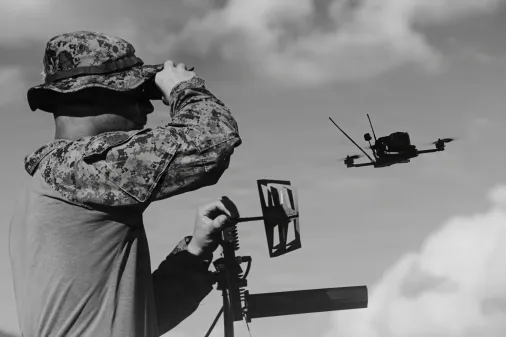Marines searching for AI-enabled sensors to detect and track unmanned systems, other targets

The Marine Corps is looking for commercially available technologies that can detect, identify and track a variety of uncrewed platforms and other targets that troops might need to engage.
The service is eyeing a potential acquisition of these types of capabilities for its Observation and Sensing System (OSS) program, according to a sources-sought notice released Thursday by Marine Corps Systems Command’s program executive office for land systems.
The program manager for ground-based air defense “is seeking interested parties that can provide force protection and littoral expeditionary advanced capability for the detection, identification, and tracking of manned and unmanned ground, air and sea vessels and personnel operating within the vicinity of specific missions,” per the RFI.
The document notes that the Marines are considering an accelerated acquisition schedule and thus officials are interested in non-developmental systems and commercially available optic and active sensor technology that’s currently at Technology Readiness Level 8 or 9.
The OSS program is pursuing a modular “family of systems” that can perform active surveillance and beef up security for the Corps’ expeditionary advanced base operations.
“OSS will detect, classify, and identify targets fusing Artificial Intelligence and Machine Learning (AI/ML) to alert security forces of activity and coordinate response force as appropriate. OSS will utilize on-board edge computing in order to minimize the data communicated to the local Command and Control (C2) system,” officials wrote in the RFI.
The program aims to integrate electro-optical/infrared (EO/IR) optics and “multi-domain” active sensors that can perform those tasks in all weather conditions from stationary locations as well as mobile platforms.
The Corps wants solutions that can spot and classify objects as small as a backpack, as well as surface vessels, ground vehicles, people, and small rotary-wing and fixed-wing drones — day or night.
Additional attributes of interest include open architecture software designs so that systems can be integrated into existing C2 systems; the ability to perform “slew-to-cue” operations; real-time display, processing and recording of video data; auto-focus and auto-tracking of targets; and the ability to relay information via multiple radio frequency sources, among others.
Signaling that the Marines are looking to acquire new tools quickly, the Corps wants RFI respondents to list how many systems they already have on hand and their production capacity in terms of timelines and quantities.
Responses are due Oct. 8.
The PEO for land systems isn’t the only office in the Department of the Navy searching for new capabilities to identify, classify and track potential threats. Last week, the DON issued a notice about its plans to test new underwater sensors and automated target recognition tools that could help protect assets.
That initiative, known as Technology Operational Experimentation Event 25.2, is part of a campaign led by the Office of Naval Research-Global that will examine emerging tech to support operational objectives related to “subsea and seabed warfare.”
One of the focus areas of that effort will be on capabilities that can monitor and defend infrastructure and facilities against adversary undersea reconnaissance via emplaced devices or underwater vehicles.
During a counter-drone panel at NDIA’s Emerging Technologies for Defense Conference and Exhibition earlier this month, Mike Dickerson, executive director of the Navy’s maritime accelerated response capability cell, highlighted the growing threats that the sea services are facing.
“It’s not just unmanned aerial systems. It is also in the surface and underwater domains. But really, from my perspective, both systems in the surface and the underwater domains are following a very similar pathway to what we saw with the unmanned aircraft threat. They may be a few years behind, but it’s following the exact same exponential increase in capability and in proliferation across the board. And obviously we’re going to continue to face these challenges as technologies evolve and as novel, innovative ways to employ them continue to change. But I personally believe that with the right approaches, the right partnerships, and really with targeting some of the investments in the appropriate areas, that we’ll remain postured to appropriately address this threat,” Dickerson said.
The pursuit of new tools to counter a variety of adversary drones is accelerating as U.S. officials observe how these types of systems are being employed in the Ukraine-Russia war and in the Middle East, where military forces, civilians and commercial ships have come under attack from unmanned aerial vehicles and uncrewed surface vessels.
The Pentagon hopes that cutting-edge tools like artificial intelligence, machine learning, autonomous systems and faster command-and-control networks will give the department an advantage over its adversaries.
At the Potomac Officers Club’s Navy Summit last week, Michael Stewart, director of the Department of the Navy’s Disruptive Capabilities Office, said he couldn’t get into specifics about where things stand with the sea services’ automated target recognition capabilities and the DCO’s efforts to boost those.
“It’s something we are very focused on. And I think you’d be, let’s say, pleasantly surprised where it is,” he told DefenseScoop.






